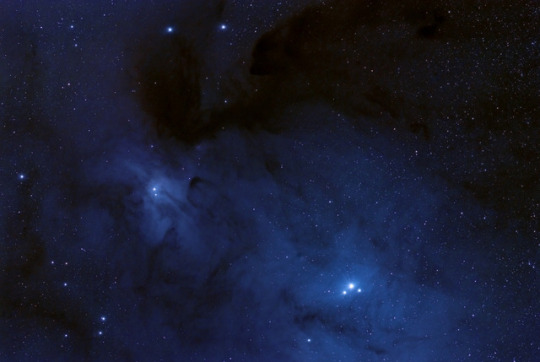Photo

Hi,I’m back!
Stickers can be found on Redbubble
78K notes
·
View notes
Photo



Centaurus A or NGC 5128 is a galaxy in the constellation of Centaurus.
The center of the galaxy contains a supermassive black hole with a mass equivalent to 55 million solar masses, which ejects a relativistic jet that is responsible for emissions in the X-ray and radio wavelengths. By taking radio observations of the jet separated by a decade, astronomers have determined that the inner parts of the jet are moving at about half of the speed of light. X-rays are produced farther out as the jet collides with surrounding gases resulting in the creation of highly energetic particles. The X-ray jets of Centaurus A are thousands of light-years long, while the radio jets are over a million light-years long
Image credit: ESO/ESA/NASA & Hubble
2K notes
·
View notes
Text
Black Hole Sculpts an Hourglass Galaxy
When it comes to galaxies, our home, the Milky Way, is rather neat and orderly. Other galaxies can be much more chaotic. For example, the Markarian 573 galaxy has a black hole at its center which is spewing beams of light in opposite directions, giving its inner regions more of an hourglass shape.

Our scientists have long been fascinated by this unusual structure, seen above in optical light from the Hubble Space Telescope. Now their search has taken them deeper than ever — all the way into the super-sized black hole at the center of one galaxy.
So, what do we think is going on? When the black hole gobbles up matter, it releases a form of high-energy light called radiation (particularly in the form of X-rays), causing abnormal patterns in the flow of gas.
Let’s take a closer look.
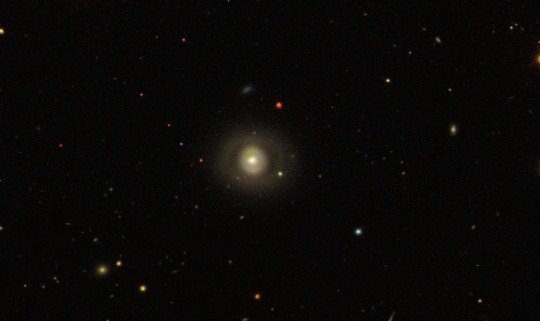
Meet Markarian 573, the galaxy at the center of this image from the Sloan Digital Sky Survey, located about 240 million light-years away from Earth in the constellation Cetus. It’s the galaxy’s odd structure and the unusual motions of its components that inspire our scientists to study it.

As is the case with other so-called active galaxies, the ginormous black hole at the center of Markarian 573 likes to eat stuff. A thick ring of dust and gas accumulates around it, forming a doughnut. This ring only permits light to escape the black hole in two cone-shaped regions within the flat plane of the galaxy — and that’s what creates the hourglass, as shown in the illustration above.

Zooming out, we can see the two cones of emission (shown in gold in the animation above) spill into the galaxy’s spiral arms (blue). As the galaxy rotates, gas clouds in the arms sweep through this radiation, which makes them light up so our scientists can track their movements from Earth.
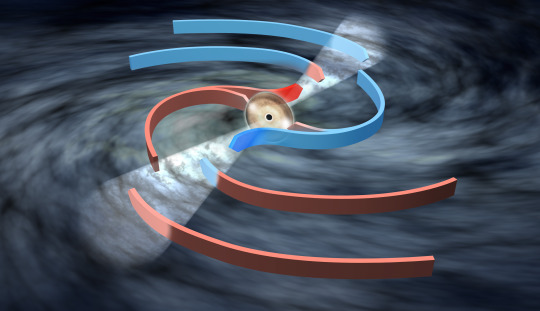
What happens next depends on how close the gas is to the black hole. Gas that’s about 2,500 light-years from the black hole picks up speed and streams outward (shown as darker red and blue arrows). Gas that’s farther from the black hole also becomes ionized, but is not driven away and continues its motion around the galaxy as before.

Here is an actual snapshot of the inner region of Markarian 573, combining X-ray data (blue) from our Chandra X-ray Observatory and radio observations (purple) from the Karl G. Jansky Very Large Array in New Mexico with a visible light image (gold) from our Hubble Space Telescope. Given its strange appearance, we’re left to wonder: what other funky shapes might far-off galaxies take?
For more information about the bizarre structure of Markarian 573, visit http://svs.gsfc.nasa.gov/12657
Make sure to follow us on Tumblr for your regular dose of space: http://nasa.tumblr.com
3K notes
·
View notes
Note
What about planet x?
Some things like the gravitational pull of objects in the outer solar system indicate that there may be another planet well beyond the orbit of Neptune. This planet - if it exists - would be 10 times more massive than Earth, and would take this new planet between 10,000 and 20,000 years to make just one complete orbit around the Sun.

Planet X or planet 9 has not yet been discovered, and there is a debate in the scientific community about whether it exists.
One of the main difficulties of detecting this planet is the distance, because it would reflect very little sunlight. But it is probable that Planet x is currently iat or near the aphelion, so perhaps if it existed it would be a good opportunity to detect it .

I’ll leave two links if you want to know more about planet x, click here and here.
Images: Caltech/R. Hurt (IPAC) & K. Batygin and M. E. Brown Astronom.
234 notes
·
View notes
Note
Can you name a few planets where it rains things? I was telling my little sister how it rains neon on Jupiter and she wants to know more.
Hello, we can find other types of rain not only on other planets, but also on moons and even brown dwarfs.
For example because of the high temperature some brown dwarfs can raining molten-iron.

and there is also rain of hydrocarbons (methane and liquid ethane) on Saturn’s moon Titan.
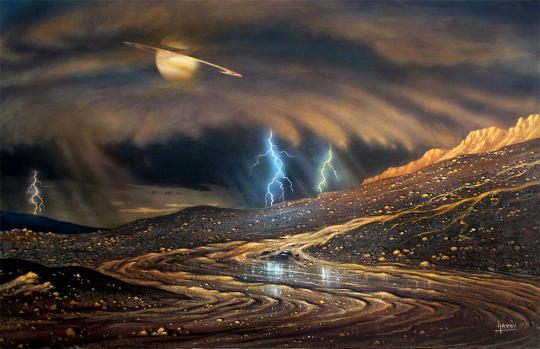
We can also mention diamond rain in Neptune, sulfuric acid rain on Venus and rain of glass on the exoplanet HD 189733b.
Below I will leave some links to that:
Sulfuric acid rain on Venus
Diamond Rain in Neptune
Rain of glass on exoplanet HD 189733b
Images credit: NASA/JPL-Caltech/University of Western Ontario/Stony Brook University & David A. Hardy (AstroArt)
2K notes
·
View notes
Photo

The Seahorse of the Large Magellanic Cloud (a star forming region very near the expansive Tarantula Nebula).
Credit: NASA, ESA, and M. Livio (STScI)
4K notes
·
View notes
Text
Webb 101: 10 Facts about the James Webb Space Telescope
Did you know…?
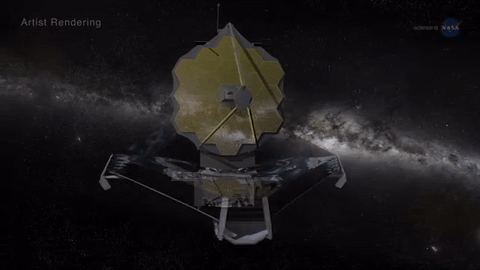
1. Our upcoming James Webb Space Telescope will act like a powerful time machine – because it will capture light that’s been traveling across space for as long as 13.5 billion years, when the first stars and galaxies were formed out of the darkness of the early universe.
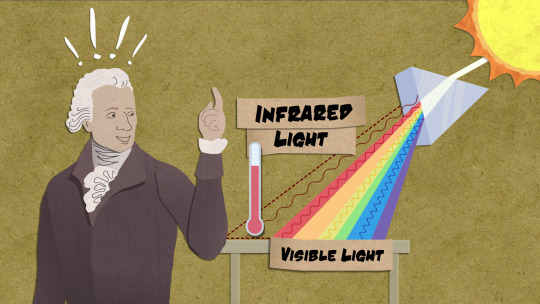
2. Webb will be able to see infrared light. This is light that is just outside the visible spectrum, and just outside of what we can see with our human eyes.

3. Webb’s unprecedented sensitivity to infrared light will help astronomers to compare the faintest, earliest galaxies to today’s grand spirals and ellipticals, helping us to understand how galaxies assemble over billions of years.
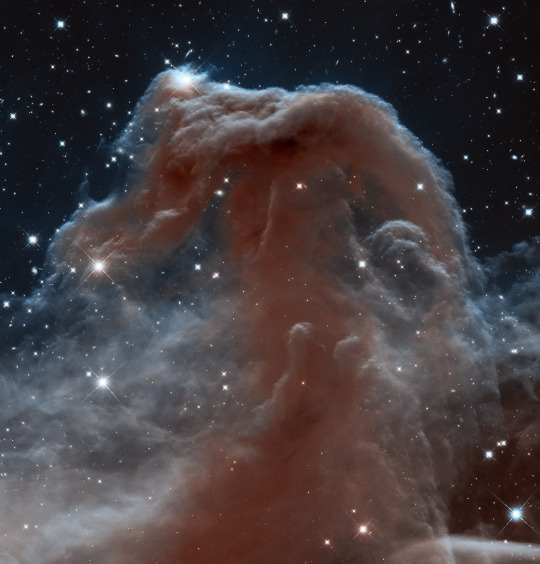
Hubble’s infrared look at the Horsehead Nebula. Credit: NASA/ESA/Hubble Heritage Team
4. Webb will be able to see right through and into massive clouds of dust that are opaque to visible-light observatories like the Hubble Space Telescope. Inside those clouds are where stars and planetary systems are born.

5. In addition to seeing things inside our own solar system, Webb will tell us more about the atmospheres of planets orbiting other stars, and perhaps even find the building blocks of life elsewhere in the universe.

Credit: Northrop Grumman
6. Webb will orbit the Sun a million miles away from Earth, at the place called the second Lagrange point. (L2 is four times further away than the moon!)

7. To preserve Webb’s heat sensitive vision, it has a ‘sunshield’ that’s the size of a tennis court; it gives the telescope the equivalent of SPF protection of 1 million! The sunshield also reduces the temperature between the hot and cold side of the spacecraft by almost 600 degrees Fahrenheit.

8. Webb’s 18-segment primary mirror is over 6 times bigger in area than Hubble’s and will be ~100x more powerful. (How big is it? 6.5 meters in diameter.)

9. Webb’s 18 primary mirror segments can each be individually adjusted to work as one massive mirror. They’re covered with a golf ball’s worth of gold, which optimizes them for reflecting infrared light (the coating is so thin that a human hair is 1,000 times thicker!).

10. Webb will be so sensitive, it could detect the heat signature of a bumblebee at the distance of the moon, and can see details the size of a US penny at the distance of about 40 km.

BONUS! Over 1,200 scientists, engineers and technicians from 14 countries (and more than 27 U.S. states) have taken part in designing and building Webb. The entire project is a joint mission between NASA and the European and Canadian Space Agencies. The telescope part of the observatory was assembled in the world’s largest cleanroom at our Goddard Space Flight Center in Maryland.
Webb is currently being tested at our Johnson Space Flight Center in Houston, TX.
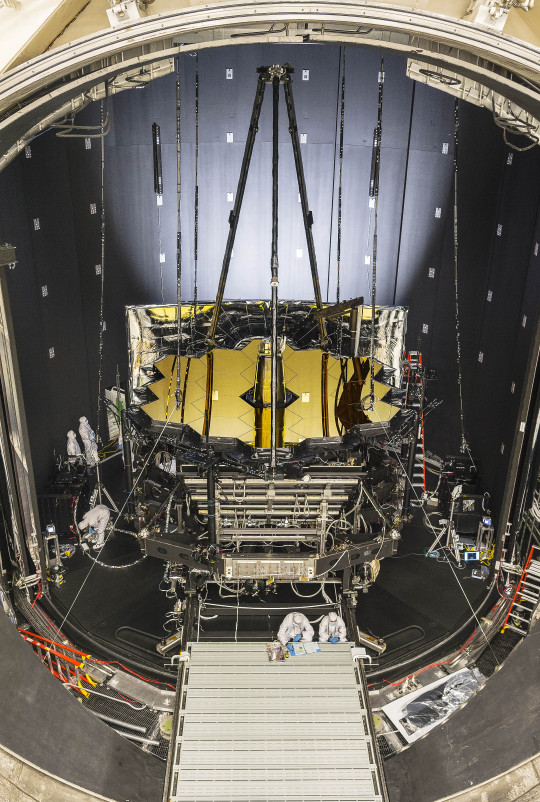
Afterwards, the telescope will travel to Northrop Grumman to be mated with the spacecraft and undergo final testing. Once complete, Webb will be packed up and be transported via boat to its launch site in French Guiana, where a European Space Agency Ariane 5 rocket will take it into space.
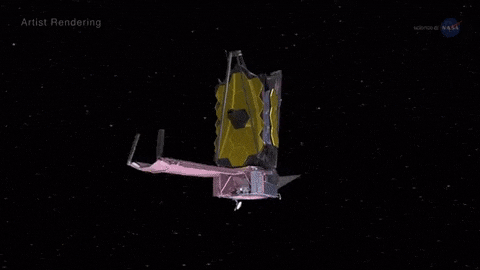
Learn more about the James Webb Space Telescope HERE, or follow the mission on Facebook, Twitter and Instagram.
Make sure to follow us on Tumblr for your regular dose of space: http://nasa.tumblr.com.
4K notes
·
View notes
Text
Black Hole Sculpts an Hourglass Galaxy
When it comes to galaxies, our home, the Milky Way, is rather neat and orderly. Other galaxies can be much more chaotic. For example, the Markarian 573 galaxy has a black hole at its center which is spewing beams of light in opposite directions, giving its inner regions more of an hourglass shape.

Our scientists have long been fascinated by this unusual structure, seen above in optical light from the Hubble Space Telescope. Now their search has taken them deeper than ever — all the way into the super-sized black hole at the center of one galaxy.
So, what do we think is going on? When the black hole gobbles up matter, it releases a form of high-energy light called radiation (particularly in the form of X-rays), causing abnormal patterns in the flow of gas.
Let’s take a closer look.

Meet Markarian 573, the galaxy at the center of this image from the Sloan Digital Sky Survey, located about 240 million light-years away from Earth in the constellation Cetus. It’s the galaxy’s odd structure and the unusual motions of its components that inspire our scientists to study it.

As is the case with other so-called active galaxies, the ginormous black hole at the center of Markarian 573 likes to eat stuff. A thick ring of dust and gas accumulates around it, forming a doughnut. This ring only permits light to escape the black hole in two cone-shaped regions within the flat plane of the galaxy — and that’s what creates the hourglass, as shown in the illustration above.

Zooming out, we can see the two cones of emission (shown in gold in the animation above) spill into the galaxy’s spiral arms (blue). As the galaxy rotates, gas clouds in the arms sweep through this radiation, which makes them light up so our scientists can track their movements from Earth.

What happens next depends on how close the gas is to the black hole. Gas that’s about 2,500 light-years from the black hole picks up speed and streams outward (shown as darker red and blue arrows). Gas that’s farther from the black hole also becomes ionized, but is not driven away and continues its motion around the galaxy as before.

Here is an actual snapshot of the inner region of Markarian 573, combining X-ray data (blue) from our Chandra X-ray Observatory and radio observations (purple) from the Karl G. Jansky Very Large Array in New Mexico with a visible light image (gold) from our Hubble Space Telescope. Given its strange appearance, we’re left to wonder: what other funky shapes might far-off galaxies take?
For more information about the bizarre structure of Markarian 573, visit http://svs.gsfc.nasa.gov/12657
Make sure to follow us on Tumblr for your regular dose of space: http://nasa.tumblr.com
3K notes
·
View notes
Note
Is HD 189773B really rains glass? How do they form?
HD 189733b is a giant extrasolar planet, resembling Jupiter. It is located about 63 light-years from Earth.The occurrence of rain glass on the exoplanet HD 189733 is due to proximity to its star. which causes daytime temperatures to rise as high as 1,700 degrees Fahrenheit (930 degrees Celsius).

According to one study, the atmosphere of HD189733b is fleeing the planet at a rate of 220 million pounds (100 million pounds) to 1.3 billion pounds (600 million kg) per second.

The blue color of its atmosphere is due to the silicate particles and with the high temperature falls in the form of rain of molten glass.

It is estimated that its winds reach 7000 km per hour.
Animation - If you want to know more about HD 189733b, click here and here.
292 notes
·
View notes
Photo



Centaurus A or NGC 5128 is a galaxy in the constellation of Centaurus.
The center of the galaxy contains a supermassive black hole with a mass equivalent to 55 million solar masses, which ejects a relativistic jet that is responsible for emissions in the X-ray and radio wavelengths. By taking radio observations of the jet separated by a decade, astronomers have determined that the inner parts of the jet are moving at about half of the speed of light. X-rays are produced farther out as the jet collides with surrounding gases resulting in the creation of highly energetic particles. The X-ray jets of Centaurus A are thousands of light-years long, while the radio jets are over a million light-years long
Image credit: ESO/ESA/NASA & Hubble
2K notes
·
View notes
Text
Solar System: Things to Know This Week
See history in the making on September 22! That’s the day OSIRIS-REx, the first U.S. mission to carry samples from an asteroid back to Earth, will make a close approach to Earth as it uses our planet’s gravity to slingshot itself toward the asteroid Bennu.

Over the course of several days, observatories and amateur astronomers will be able to spot the spacecraft. Below, 10 things to know about this incredible mission that will bring us the largest sample returned from space since the Apollo era.
1. Big Deal

OSIRIS-REx seeks answers to the questions that are central to the human experience: Where did we come from? What is our destiny? Asteroids, the leftover debris from the solar system formation process, can help us answer these questions and teach us about the history of the Sun and planets.
2. That’s a Long Acronym
Yup. OSIRIS-REx stands for the Origins, Spectral Interpretation, Resource Identification, Security-Regolith Explorer spacecraft. The gist: It will rendezvous with, study, and return a sample of the asteroid Bennu to Earth.
3. Lots of Instruments, Too

While all the acronyms for each instrument may be alphabet soup, each has a job/role to perform in order to complete the mission. Explore what each one will do in this interactive webpage.
4. Nice to Meet You, Bennu
Scientists chose Bennu as the mission target because of its composition, size, and proximity to Earth. Bennu is a rare B-type asteroid (primitive and carbon-rich), which is expected to have organic compounds and water-bearing minerals like clays.
5. Hard Knock Life
youtube
Bennu had a tough life in a rough neighborhood: the early solar system. It’s an asteroid the size of a small mountain born from the rubble of a violent collision, hurled through space for millions of years and dismembered by the gravity of planets—but that’s exactly what makes it a fascinating destination.
6. High Fives All Around
In 2018, OSIRIS-REx will approach Bennu and begin an intricate dance with the asteroid, mapping and studying Bennu in preparation for sample collection. In July 2020, the spacecraft will perform a daring maneuver in which its 11-foot arm will reach out for a five-second “high-five” to stir up surface material, collecting at least 2 ounces (60 grams) of small rocks and dust into a sample return capsule.
7. Home Sweet Home
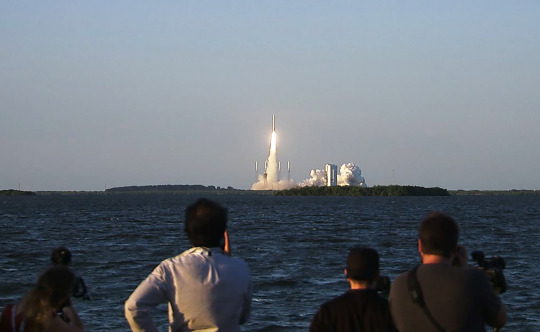
OSIRIS-REx launched on September 8, 2016 from Cape Canaveral, Florida on an Atlas V rocket. In March 2021, the window for departure from the asteroid will open and OSIRIS-REx will begin its return journey to Earth, arriving two-and-a-half years later in September 2023.
8. Precious Cargo

The sample will head to Earth inside of a return capsule with a heat shield and parachutes that will separate from the spacecraft once it enters the Earth’s atmosphere. The capsule containing the sample will be collected at the Utah Test and Training Range. Once it arrives, it will be transported to NASA’s Johnson Space Center in Houston for examination. For two years after the sample return (from late 2023-2025) the science team will catalog the sample and conduct the analysis needed to meet the mission science goals. NASA will preserve at least 75% of the sample at NASA’s Johnson Space Flight Center in Houston for further research by scientists worldwide, including future generations of scientists.
9. Knowledge Is Power
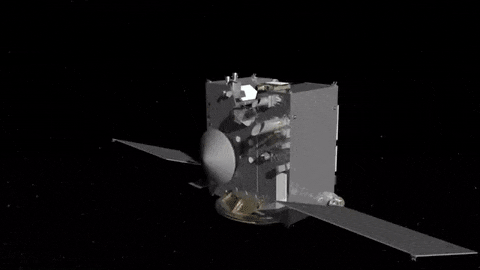
Analyzing the sample will help scientists understand the early solar system, as well as the hazards and resources of near-Earth space. Asteroids are remnants of the building blocks that formed the planets and enabled life. Those like Bennu contain natural resources such as water, organics and metals. Future space exploration and economic development may rely on asteroids for these materials.
10. Hitch a Ride
Journey with OSIRIS-REx as it launches, cruises, and arrives to Bennu in this interactive timeline.
Make sure to follow us on Tumblr for your regular dose of space: http://nasa.tumblr.com
2K notes
·
View notes
Photo

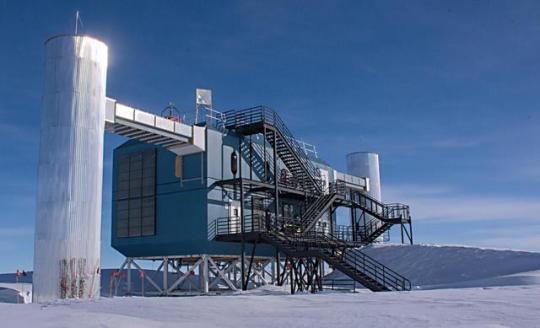






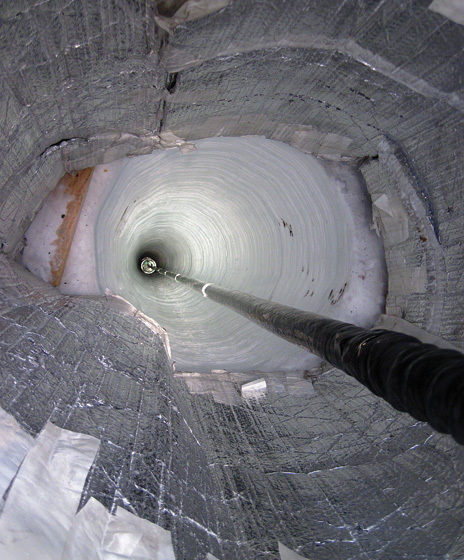
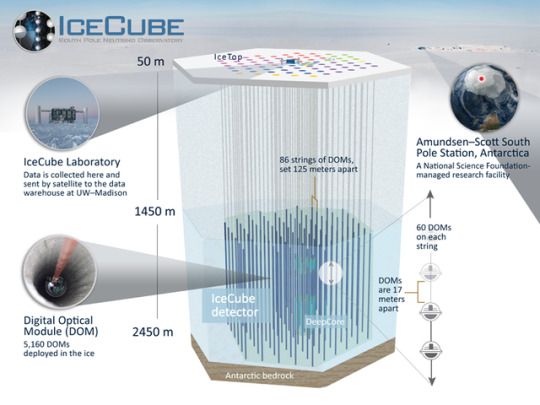
IceCube ( IceCube Neutrino Observatory)
IceCube, the South Pole neutrino observatory, is a cubic-kilometer particle detector made of Antarctic ice and located near the Amundsen-Scott South Pole Station. It is buried beneath the surface, extending to a depth of about 2,500 meters. A surface array, IceTop, and a denser inner subdetector, DeepCore, significantly enhance the capabilities of the observatory, making it a multipurpose facility.
IceCube is the first gigaton neutrino detector ever built and was primarily designed to observe neutrinos from the most violent astrophysical sources in our universe. Neutrinos, almost massless particles with no electric charge, can travel from their sources to Earth with essentially no attenuation and no deflection by magnetic fields.
The in-ice component of IceCube consists of 5,160 digital optical modules (DOMs), each with a ten-inch photomultiplier tube and associated electronics. The DOMs are attached to vertical “strings,” frozen into 86 boreholes, and arrayed over a cubic kilometer from 1,450 meters to 2,450 meters depth. The strings are deployed on a hexagonal grid with 125 meters spacing and hold 60 DOMs each. The vertical separation of the DOMs is 17 meters.
Eight of these strings at the center of the array were deployed more compactly, with a horizontal separation of about 70 meters and a vertical DOM spacing of 7 meters. This denser configuration forms the DeepCore subdetector, which lowers the neutrino energy threshold to about 10 GeV, creating the opportunity to study neutrino oscillations.
IceTop consists of 81 stations located on top of the same number of IceCube strings. Each station has two tanks, each equipped with two downward facing DOMs. IceTop, built as a veto and calibration detector for IceCube, also detects air showers from primary cosmic rays in the 300 TeV to 1 EeV energy range. The surface array measures the cosmic-ray arrival directions in the Southern Hemisphere as well as the flux and composition of cosmic rays.
Developments in neutrino astronomy have been driven by the search for the sources of cosmic rays, leading at an early stage to the concept of a cubic-kilometer neutrino detector. Cosmic rays, which consist mainly of protons, are the highest energy particles ever observed, with energies over a million times those reached by today’s particle accelerators on Earth.
AMANDA, the Antarctic Muon and Neutrino Detector Array, was built as a proof of concept in the mid 1990s and demonstrated that the extremely clear Antarctic ice was suitable for detecting energetic neutrinos. IceCube, the only cubic-kilometer neutrino detector constructed to date, was completed in December 2010, only six years after the deployment of the first string at the South Pole.
Neutrinos are not observed directly, but when they happen to interact with the ice they produce electrically charged secondary particles that in turn emit Cherenkov light, as a result of traveling through the ice faster than light travels in ice.
The IceCube sensors collect this light, which is subsequently digitized and time stamped. This information is sent to computers in the IceCube Lab on the surface, which converts the messages from individual DOMs into light patterns that reveal the direction and energy of muons and neutrinos.
The IceCube Neutrino Observatory was built under a National Science Foundation (NSF) Major Research Equipment and Facilities Construction grant, with assistance from partner funding agencies around the world. The NSF Office of Polar Programs supports the project with a Maintenance and Operations (M&O) grant. The University of Wisconsin–Madison is the lead institution, coordinating data-taking and M&O activities. The international IceCube Collaboration, with more than 40 institutions worldwide, is responsible for the scientific research program.
Source: icecube.wisc.edu Images: iceCube/NSF,Mike Lucibella, Sven Lidstrom, Jim Haugen, B. Gudbjartsson.
3K notes
·
View notes
Photo

BLANKET MAGAZINE: LOOKING FOR WRITERS!!!
‘Blanket Magazine’, a project that I am working on for my Visual Design graduation exhibition, is going to be a collection of articles written by intersectional feminists who are aware and willing to speak out about the issues in our current entertainment industry and fandom spaces.
Each issue of Blanket Magazine will focus on a different genre, and “Science Fiction” will be the genre for this first issue.
So if you’re a feminist, into sci-fi, and have something you want to speak out about…apply!
*please read the information below if you are interested
**apply here
Keep reading
3K notes
·
View notes
Photo

In this image, Space Shuttle Challenger waits on Launch Complex 39A at Kennedy Space Center before its first mission, STS-6, launched on April 4, 1983. Originally built as a test vehicle, in 1979 NASA issued a contract to convert it to a fully space-rated orbiter. It became the second operational Shuttle, delivered to Kennedy Space Center in July 1982. Challenger was destroyed shortly after lift off on her 10th mission, STS-51L, on January 28, 1986.
Image credit: NASA
2K notes
·
View notes
Text
Observing the Ozone Hole from Space: A Science Success Story
Using our unique ability to view Earth from space, we are working together with NOAA to monitor an emerging success story – the shrinking ozone hole over Antarctica.

Thirty years ago, the nations of the world agreed to the landmark ‘Montreal Protocol on Substances that Deplete the Ozone Layer.’ The Protocol limited the release of ozone-depleting chlorofluorocarbons (CFCs) into the atmosphere.

Since the 1960s our scientists have worked with NOAA researchers to study the ozone layer.

We use a combination of satellite, aircraft and balloon measurements of the atmosphere.

The ozone layer acts like a sunscreen for Earth, blocking harmful ultraviolet, or UV, rays emitted by the Sun.

In 1985, scientists first reported a hole forming in the ozone layer over Antarctica. It formed over Antarctica because the Earth’s atmospheric circulation traps air over Antarctica. This air contains chlorine released from the CFCs and thus it rapidly depletes the ozone.
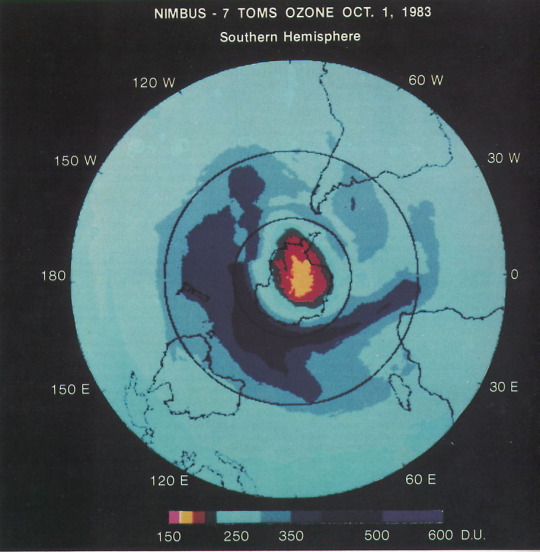
Because colder temperatures speed up the process of CFCs breaking up and releasing chlorine more quickly, the ozone hole fluctuates with temperature. The hole shrinks during the warmer summer months and grows larger during the southern winter. In September 2006, the ozone hole reached a record large extent.

But things have been improving in the 30 years since the Montreal Protocol. Thanks to the agreement, the concentration of CFCs in the atmosphere has been decreasing, and the ozone hole maximum has been smaller since 2006’s record.

That being said, the ozone hole still exists and fluctuates depending on temperature because CFCs have very long lifetimes. So, they still exist in our atmosphere and continue to deplete the ozone layer.
To get a view of what the ozone hole would have looked like if the world had not come to the agreement to limit CFCs, our scientists developed computer models. These show that by 2065, much of Earth would have had almost no ozone layer at all.

Luckily, the Montreal Protocol exists, and we’ve managed to save our protective ozone layer. Looking into the future, our scientists project that by 2065, the ozone hole will have returned to the same size it was thirty years ago.
Make sure to follow us on Tumblr for your regular dose of space: http://nasa.tumblr.com
4K notes
·
View notes

